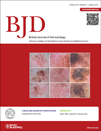Interleukin-4 genetic variants correlate with its transcript and protein levels in patients with vitiligo
Funding sources Department of Biotechnology grant to R.B. (BT/PR9024/MED/12/332/2007) New Delhi, India, University Grants Commission grant to R.B. [F. No. 36-158/2008(SR)], New Delhi, India and Gujarat State Biotechnology Mission grant to R.B. (GSBTM/MD/PROJECTS/SSA/453/2010-2011), Gujarat, India.
Conflicts of interest None declared.
M.I. and N.C.L. contributed equally to this work.
Summary
Background Vitiligo is an acquired pigmentary disorder resulting from loss of melanocytes. Interleukin (IL)-4 has been shown to stimulate B-cell proliferation, to regulate immunoglobulin class switching (IgG1 and IgE) and to promote T-cell development. Polymorphisms in the IL4 gene are known to increase its expression, thereby implicating its role in vitiligo susceptibility.
Objectives To explore intron 3 VNTR (IVS3) and -590 C/T (rs2243250) promoter polymorphisms in the IL4 gene and to correlate them with the IL4 transcript, serum IL-4 and IgE levels to achieve genotype–phenotype correlation in patients with vitiligo from Gujarat. A replication study was done in a North Indian population.
Methods The case–control study was performed to investigate these polymorphisms in 505 patients and 744 controls in Gujarat, and 596 patients and 397 controls in North India by polymerase chain reaction (PCR) and PCR-restriction fragment length polymorphism analysis. IL4 transcript levels were monitored by real-time PCR. Serum IL-4 and IgE levels were measured by enzyme-linked immunosorbent assay and electrochemiluminescence immunoassay, respectively.
Results The genotype frequencies differed significantly between patients with generalized vitiligo and controls for both the polymorphisms in both populations. Allele frequencies significantly differed between patients with generalized vitiligo and controls for both the polymorphisms in the population from Gujarat. Interestingly, genotype and allele frequencies for -590 C/T single nucleotide polymorphism were significantly different between patients with localized vitiligo and controls in both the populations. The study revealed significantly increased IL4 mRNA, serum IL-4 and IgE levels in patients from Gujarat. Age of onset analysis of disease in patients suggested that the TTR2R2, TTR1R2 and CTR2R2 haplotypes had a profound effect in the early onset of the disease.
Conclusions Our results suggest that these polymorphisms of the IL4 gene may be genetic risk factors for susceptibility towards vitiligo and the upregulation of the IL4 transcript, protein and IgE levels in individuals with susceptible haplotypes reveal the crucial role of IL-4 in the pathogenesis of vitiligo.




